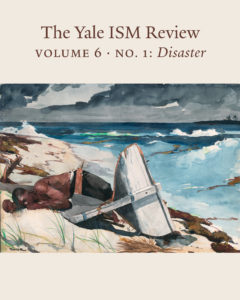Margaret Olin
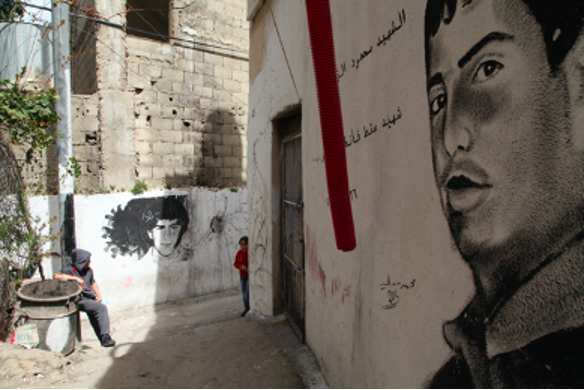
1. Murals by Mohammad Ma’ali portray two martyrs from Dheisheh: in the foreground, Mahmoud Zaghari, killed in 2004 at the age of 22 during a clash with Israeli troops in Bethlehem, and in the background Nasser Alqasass, 15, killed in 1989 after stepping outside his home during a curfew. Photograph © 2016 Margaret Olin.
In 1948 and again in 1967, the parents and grandparents of the young people in these photographs fled villages throughout the area that is now Israel and the West Bank. They found shelter in the Dheisheh refugee camp, established in 1949 on the edge of Bethlehem by the United Nations Relief and Works Agency (UNRWA), under whose supervision it remains.
Dheisheh was originally established as a tent city on 1/3 square kilometers, meant only as a temporary solution while refugees waited to return to their homes. Over 70 years later, the “camp” is now a crowded urban area that houses about 15,000 registered inhabitants, nearly half of them children. Most of them continue to wait.
I have written elsewhere of the depiction of waiting that continues, in words and images, on the crowded walls of the camp.[1] But beyond images of waiting, those walls, almost alive with oversize faces of the dead, turn a refugee camp visually into a memorial city through which the inhabitants wend their way, live their lives, and argue.
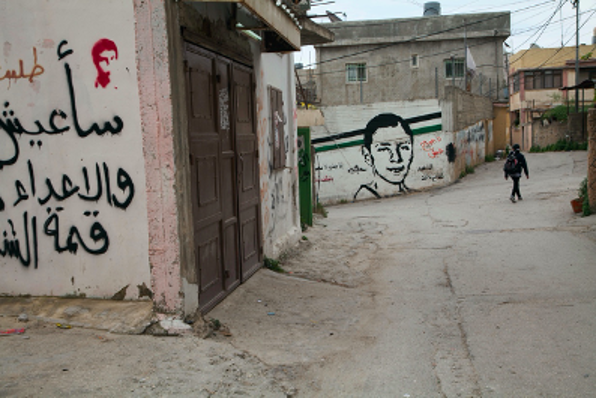
2. Kifah Obeid, a 12-year old killed in 2001 while throwing stones. Photograph © 2016 Margaret Olin.
The event that gave rise to Dheisheh, and other refugee camps like it, is known to Palestinians as “the disaster,” or in Arabic, Nakba. In this brief essay I would like to raise the possibility of taking seriously the meaning of the word Nakba, and of considering these painting practices in the light of the ongoing disaster of the Israeli occupation.
By bringing to life these haunting faces that loom above the inhabitants, and above the children who argue, play, and live their lives there, I hope also to illuminate the interplay between disaster ritual, private mourning practices, and politics. The story I tell focuses on only one camp, but it is representative of many cities and camps in Palestine and beyond, in Jordan or Lebanon.
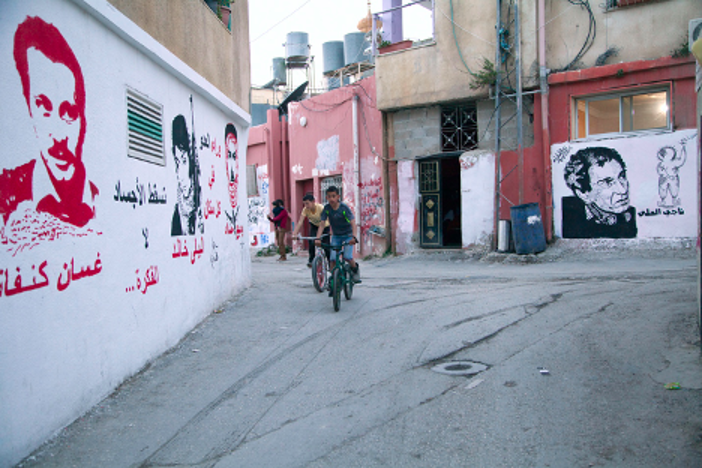
3. The murals, by Mohammad Maily, show three important figures from the PFLP, the writer Ghassan Kanafani, the leader Wadie Haddad, and the (still living) Layla Khalid, known for attempting to hijack two airplanes. On the right is depicted Naji al-Ali, political cartoonist assassinated in 1987. Photograph © 2015 Margaret Olin.
The dead in these murals include martyrs of Dheisheh and martyrs of Palestine, assassinated cultural and political leaders, and revolutionary figures from abroad. Assassinated political leaders, like the noted author of “Return to Haifa” and other works, Gassan Kanafani, rub shoulders with Che Guevara, and with teenage boys who were in the act (or under suspicion) of throwing stones or crude Molotov cocktails at demonstrations. Some were killed while helping wounded demonstrators, some while attempting to evade arrest for other punishable offenses. Belonging to a “cell” that could hatch a plan to throw rocks at soldiers was one such offense.
Many of the murals display the insignias of political parties. Often these parties, including the Popular Front for the Liberation of Palestine (PFLP), or Fatah, the party in power in the Palestinian National Authority, have paid for the materials to create the murals. The political and military context of the practice of painting murals for martyrs on the walls here, which seems to date from the beginning of the Second Intifada in 2000, supports their interpretation as propaganda, much like the posters of martyrs that have played an important role in the visual culture of Palestine since at least the 1970s. In addition, the visual culture of murals and posters are sometimes regarded as contributing to the normalization of violence.[2]
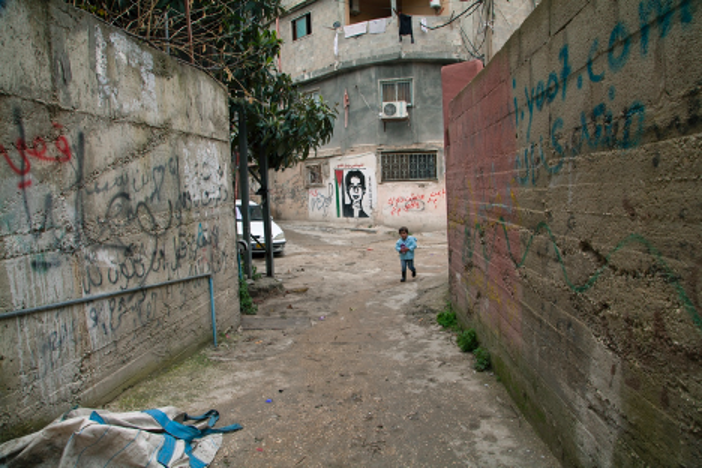
4. A mural for Qusay Al-Afandi, who was killed by Israeli troops at the age of 17 in 2008. Photograph © 2015 Margaret Olin.
Certainly, political aims play a role in the creation of the murals, which explains the eagerness of political parties to subsidize them. Yet it is unjust to dismiss them as political propaganda alone. They have other purposes. Many of the murals portray young people from Dheisheh, some not much older than the children who play under their images. They are well known to the children as relatives: parents, sisters and brothers, nieces and nephews, and cousins. While the nearby separation wall is a “global message board,” the murals in Dheisheh are generally made by residents of the camp.[3] They are personal and communal. Indeed, the personal is political in the murals of Dheisheh. And sometimes, as we shall see, in the tension between these two realms, the ritual evolves.
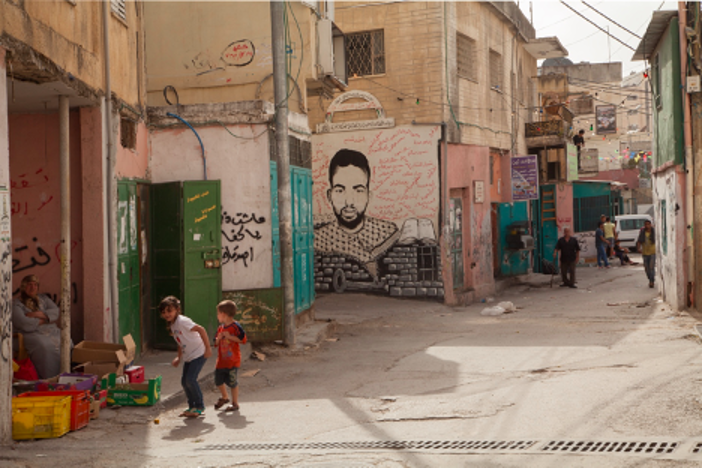
5. The mural, by Yazan Ghareeb, in memory of Ahmed Mesleh, contains names of young people of the camp killed by Israeli soldiers. Photograph © 2014 Margaret Olin.
Established practices of communal mourning enable families and friends of the deceased, and their traumatized community, to deal repeatedly with immense and ongoing loss. The martyrs of Dheisheh have, in essence, two public homes. First, the Cemetery of Martyrs established at the base of the camp in 2000, to hold the martyrs of the then just beginning Second Intifada, when nearby cemeteries, one at the Aisha camp and another southeast of Bethlehem, were inaccessible.
Not all martyrs from Dheisheh since then have been buried in the “Cemetery of Martyrs,” but fifty-three of them have been, and on the first day of Eid, as many as two hundred people may visit the tiny cemetery.[4] Every morning, the father of one martyr reads the Koran on his balcony overlooking the cemetery where his 17-year-old son Sajed, a medic killed while attempting to administer to an injured protestor, and his 14-year-old nephew Arkan, shot after throwing a stone at a departing military vehicle, were buried within a year of one another.[5]
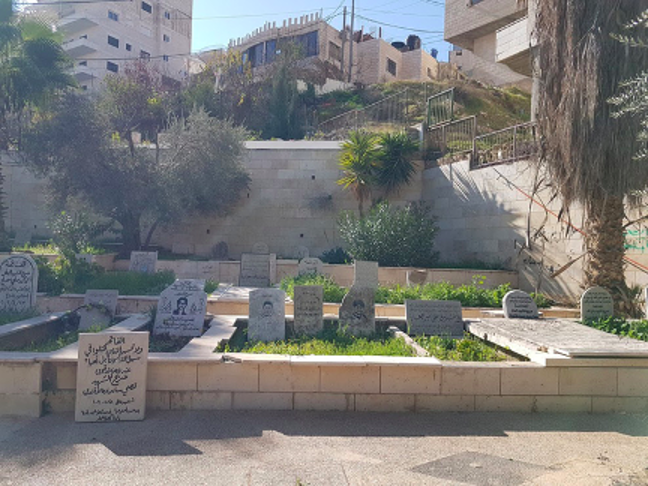
6. Cemetery of the Martyrs, Dheisheh. Photograph © Omar Hmidat.
Soon after their burial, martyrs find a second home closer to the living, in murals that are usually placed on the street where they resided. The family, or an organization, may contact an artist, negotiate over the content, and subsidize the materials. The artist often paints late at night to avoid attracting a crowd. Children are often eager to show you the portraits of their martyrs.[6]

7. The younger sister of Arkan Mizhar sits under his memorial mural by Omar Salim. Photograph © 2019 Margaret Olin.
Some disasters, like earthquakes and terrorist attacks, are sudden and over in minutes. Others, like a pandemic, may last a year or more. The disaster, the Nakba, that initiated the situation in which the refugees find themselves, was singular and sudden, and the 1967 defeat, also a disaster for Palestine, was over even more quickly.
Yet the occupation that followed both of these disasters has itself the characteristic of an ongoing disaster, with the need constantly to brace oneself for immediate losses: of youth who fall to the bullets of soldiers, of permits to work in Israel, of one’s home, when it is destroyed because someone who lives in it has become a suspect.
For refugees in camps, the ongoing disaster emerges from the provisional character of a life in suspension, the making of a lifelong home in what was meant to be temporary quarters, while one nominally waits to return to a normal that is all but forgotten.[7]
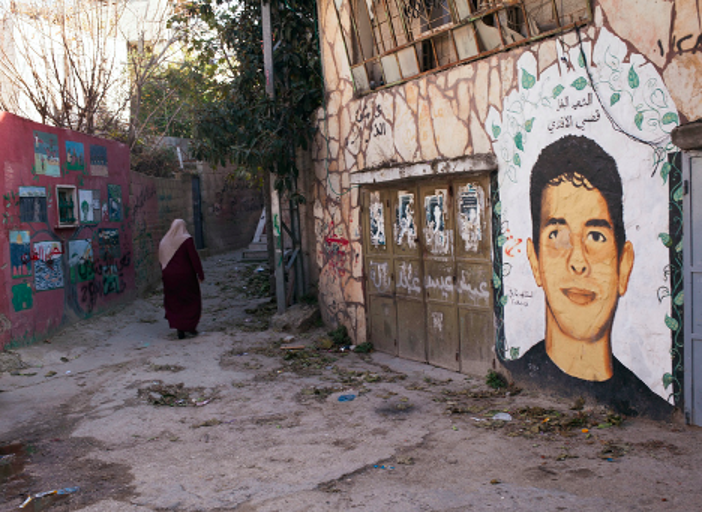
8. Ayed Arafah, mural for Qusai Al Afandi, killed in 2008 while throwing stones during a raid. Photograph © 2017 Margaret Olin.
The burial of a martyr and his reappearance on the street help to restore order, to build the new normal that is a major function of a disaster ritual. Yet the ongoing deaths of young people in Dheisheh, a few each year, continue to punctuate periods of relative order as the disaster continues.
The expectation and fulfilment of these rituals help people manage the multiple losses, but the very phenomenon shows that a disaster ritual can be a double-edged sword.
Ronald Grimes speculated, in reference to the commemoration of the destruction of the World Trade Center in New York in 2001, that ritual disaster practices can play into nationalist propaganda.[8] Similarly, some within the Dheisheh community, including some muralists, also speculate that large murals of martyrs characterized as warriors could encourage the worship of militarism, at the expense of overlooking much of value in Palestinian culture. These attitudes often leave their mark on the walls themselves.
Yet now that the idea of the martyr mural has been embedded in the culture, it has become impossible for artists, who are all themselves camp residents, to refuse the request for a mural from the family of a martyr. The likelihood that organizations such as the PFLP will take advantage of a family’s grief for the purpose of propaganda does not make it easier to refuse.
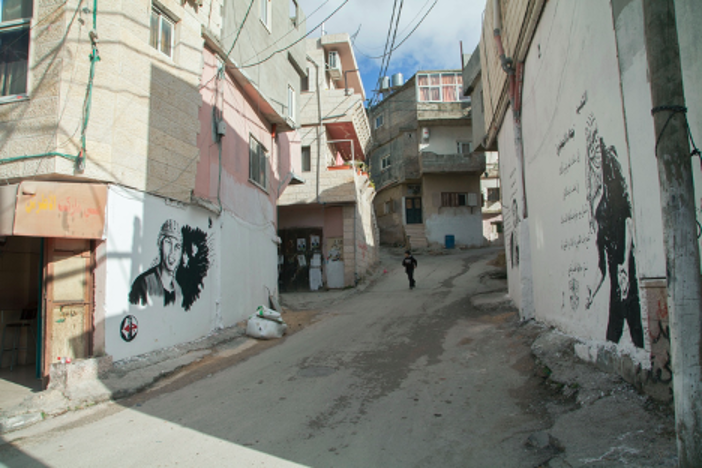
9. Left: Ahmed Hmeedat, Mural for Jihad al-Jaafary, 20, who was killed in 2015 while standing on his rooftop during a raid. Right: anonymous mural for Jihad al-Jaafary. Photograph © 2015 Margaret Olin.
The friction between the personal and the political is sometimes felt in negotiations over the murals. A fraught negotiation can take place, for example, over an attempt to portray the deceased as anything other than a warrior, even when the martyr himself had little interest in being a “warrior.”
In one case, competing representations resulted in the transformation of a narrow street into a painted dispute. Jihad al Jaafary, a twenty-year old who was shot by Israeli troops on the roof of his house in early 2015, was portrayed throwing stones in a mural on one side of the street where he lived, while on the opposite side the artist Ahmed Hmeedat portrayed him in his dancing costume. The political sponsor insisted on the inclusion of a weapon, so Hmeedat provided one of the doves surrounding Jaafary with an M16 rifle. A poster appeared on the street as well. In accord with the consistently more propagandistic tendency of posters, it portrayed the young man with an arsenal of weapons that, I was told, he never owned.[9]
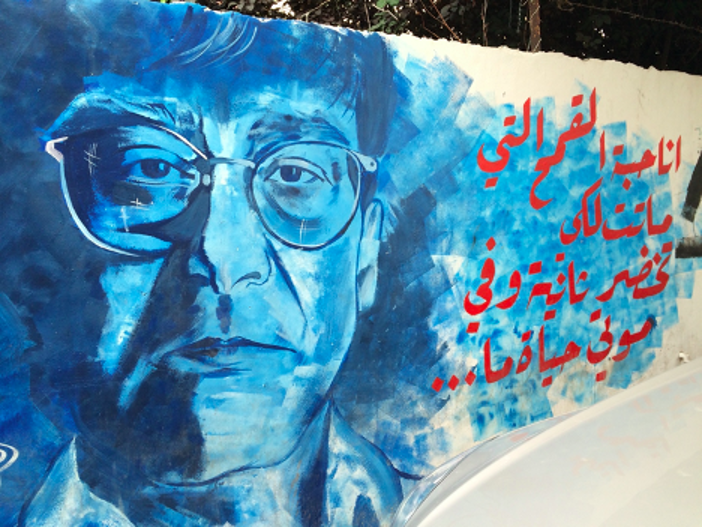
10. Ahmed Hmeedat, mural of poet Mahmoud Darwish, with a quotation from his work. Photograph © 2014 Margaret Olin.
Some artists tried, with varying degrees of subtlety, to amend the ritual to express less militant values. The artist Ayed Arafah thought that the harsh, black and white style of the murals emphasized the grim celebration of violent death, and that painting murals in color would insert more life into the walls. Hmeedat went further by adding new subjects to the murals. If warriors – and innocent young people disguised as them – were the only heroes, he reasoned, then the Palestine that children are brought up to treasure is not worth fighting for. He began painting, in color, the likenesses of deceased cultural figures on the walls.
With or without color, the visual culture of the cemetery below and that of the city above have begun to blend, as the likenesses on the walls have begun to appear on tombstones, and residents have begun to identify the two spaces with one another.
“It is a bit disturbing to think about the empty graves in these cemeteries: built and open graves, as if they are awaiting the next martyr,” one resident told me. “Just like an empty wall, awaiting the next face.”[10]
There will probably be more faces soon.
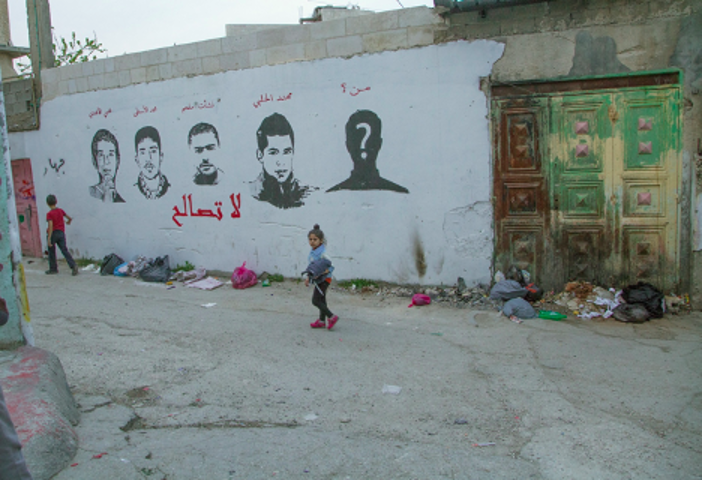
11. Who will be next? Dheisheh Refugee Camp. Photograph © 2016 Margaret Olin.
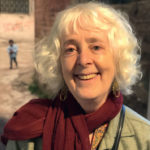
Margaret Olin
Margaret Olin has appointments at Yale Divinity School as well as in Yale’s Department of Religious Studies, the Program in Jewish Studies and the Department of the History of Art. She is the author of three books, Forms of Representation in Alois Riegl’s Theory of Art (Penn State Press, 1992), The Nation Without Art: Examining Modern Discourses in Jewish Art (University of Nebraska, 2001), and Touching Photographs (University of Chicago Press, 2012). With Robert S. Nelson, she edited Monuments and Memory, Made and Unmade (University of Chicago Press, 2003), and with Steven Fine and Maya Balakirsky-Katz, she edits the journal Images: A Journal of Jewish Art and Visual Culture. She is also a practicing photographer, whose photographic work plays a fundamental role in her scholarship. Her interests include Jewish spatial practices, theories of perception, and the theory and practice of visual witnessing. Some of these concerns can be followed on the occasional blog touchingphotographs.wordpress.com.
[1] Margaret Olin, “How Long Will Handala Wait? A Ten-Year-Old Barefoot Refugee Child on Palestinian Walls,” in Christoph Singer, Robert Wirth and Olaf Berwald, ed. Timescapes of Waiting: Spaces of Stasis, Delay and Deferral (Leiden: Brill, 2019), 176-197.
[2] “No longer marked off with the intensity of an “event,” except at particular moments, death and violence form part of the “totalitarian overcoding of social life” (Hardt and Negri 2000:113) that is typical of moments of high nationalism,” Lori Allen, “Getting by the Occupation: How Violence Became Normal during the Second Palestinian Intifada,” Cultural Anthropology 23 (August, 2008): 453-487.
[3] Craig Larkin, “Jerusalem’s Separation Wall and Global Message Board; Graffiti, Murals, and the Art of Sumud,” The Arab Studies Journal 22, no. 1 (Spring 2014): 134-169; Special Issue: Cultures of Resistance.
[4] Rebecca George, “Photo Essay: A Visit to Bethlehem’s Martyr Cemetery,” Mondoweiss (21 July 2015), https://mondoweiss.net/author/rebecca-george/. For a nuanced discussion of martyrs’ funerals, see Lori A. Allen, “The Polyvalent Politics of Martyr Commemorations in the Palestinian Intifada” History and Memory 18, no. 2 (2006): 107-138; special issue: Home and Beyond: Sites of Palestinian Memory.
[5] Interview with Om Tha’er, grandmother of the two young men, in 2019, three months after the second death, of 17-year-old Sajed Mizher.
[6] Philip Hopper notes the children’s identification with the martyrs, without, however, mentioning their personal relationship with them. “Beyond the Wall in Dheisheh Camp: From Local to Transnational Image-Making,” Pedagogy and the Theater of the Oppressed Journal 1 (article 7), https://scholarworks.uni.edu/ptoj/vol1/iss1/7
[7] Ronald Perry, “What is a Disaster?” in Havidán Rodríguez, Enrico L. Quarantelli, and Russel R. Dynes, ed. Handbook of Disaster Research (New York: Springer, 2006), 5-6.
[8] Ronald Grimes, “Ritualizing September 11,” Rite out of Place: Ritual, Media and the Arts (Oxford, New York: Oxford University Press, 2006), 85-6.
[9] Ahmed Hmeedat, personal communication.
[10] Omar Hmidat, personal communication.
